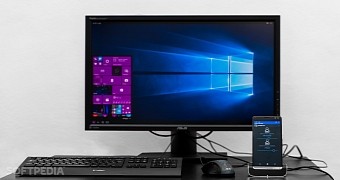Back in 2012 when Microsoft introduced the original Surface 2-in-1, Apple executives and even CEO Tim Cook himself laughed off Redmond’s new device, calling it just a weird mix of a toaster and a refrigerator.
More recently, however, the success recorded by 2-in-1 devices in general, and Microsoft’s Surface in particular, convinced Apple it was the time to expand in this product category too, so the iPad was upgraded with a detachable keyboard that brought it closer to the concept that Microsoft invented in 2012.
And now, it looks like Apple is once again looking at its rival for a feature that could arrive on future iPhones. A new patent that was spotted a few days ago reveals that Cupertino is exploring a feature that looks a lot like Microsoft’s own Continuum, which is available on select Windows 10 Mobile devices.
Samsung and Apple looking into Continuum-like features
Microsoft is one of the first companies that invested in this approach of converting phones to PCs when connected to bigger screens, and now it looks like this idea is catching the attention of other large phone companies too, including both Samsung and Apple.
Samsung is expected to take the wraps off a similar feature later this month with the introduction of the brand-new Galaxy S8, and later this year, Apple could do the same with the next-generation iPhone.
According to this patent, Apple might be planning an accessory sold separately that comes in the form of a laptop without the processing power, with the iPhone to play the essential role when plugged in. This would work similar to HP’s own Lapdock, and would require the iPhone to be connected to this device in order to turn the smartphone into a portable PC.
The accessory could come with a wide array of connectivity ports, and could also feature a dedicated GPU unit, plus a keyboard, obviously. What’s interesting is that the iPhone could be plugged in where the touchpad usually resides on a laptop, so its screen could be used for controlling the cursor.
Apple hasn’t yet confirmed anything related to this project and it’s still in patent stage, but there’s no doubt that the idea Microsoft adopted for its Windows phones is gaining much more attention these days, especially from rivals who invest much more in smartphones.
Continuum improvements
Microsoft itself is also committed to improving Continuum, and the company is already working on a series of new features, most of them supposed to make the whole experience more similar to what you can get on a PC running the full version of Windows 10.
Future versions of Continuum would come with support for resizable windows, but also with a fully-featured taskbar with a system tray and everything.
Users would be able to pin apps to the taskbar, minimize running apps, and get full multitasking, which is a feature that can’t miss from a device supposed to emulate the PC experience.

 14 DAY TRIAL //
14 DAY TRIAL //